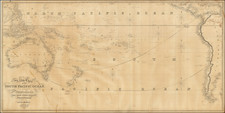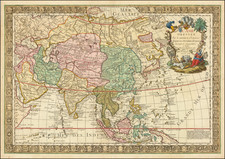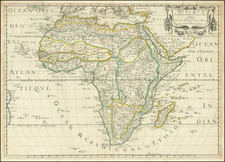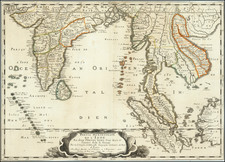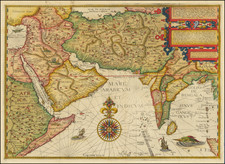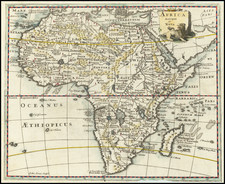This 1810 map titled "A Chart of the General Track to and from India, Illustrating the Voyages of Lord Valentia," was drawn to accompany the report of George Macartney's the diplomatic embassy to China on behalf of George III.
The chart documents the squadron's track from London to Beijing from October 1792 to September 1794, including daily readings of atmospheric pressure and temperature. The map offers updated information on political and cultural divisions in China and neighboring Asian regions, some of which remained unmapped in detail until much later. New Chinese terminology is used to replace older geographical names from sources like Ptolemy, including "Tartars of Little Bucharia: subject to the Empire of China, anciently Scythia extra imaum."
An important detail on the map concerns the sea between Japan and Korea. It identifies this sea as the "Sea of Korea," also known as the "East Sea," or "Sea of Japan." The term "East Sea" has been used by Korea since 59 B.C., while many books and maps published before Japan's annexation of Korea referred to it as the "East Sea" or "Sea of Korea." Different terms have been used throughout history, with Russian and French maps alternating between "Sea of Korea" and "Eastern Ocean," and eventually adopting "Sea of Japan," which gained worldwide popularity. The name continues to be a point of historical and political dispute between the countries.
The Macartney Mission, also known as the Macartney Embassy, was a diplomatic mission by Great Britain to the Qianlong Emperor of the Qing Dynasty. Its aim was to expand British trading rights in China and establish a permanent embassy in Beijing. The East India Company had previously been limited to trading through sanctioned traders in Guangzhou (Canton), but desired a direct link to Beijing. A prior mission led by Charles Cathcart in 1787 failed when Cathcart died before reaching China.
The 1792 mission led by George Macartney included translators, painters, secretaries, scholars, and scientists, traveling through Madeira, Tenerife, Rio de Janeiro, the Cape of Good Hope, Indonesia, and Macau, before reaching Beijing in August 1793. George Leonard Staunton served as the mission's secretary, and his son George Thomas Staunton, acting as the ambassador's page, learned Chinese and helped translate, alongside Catholic priests Paolo Zhou and Jacobus Li Zibiao. The younger Staunton later became a significant figure in the East India Company's factory at Guangzhou and contributed to translations and founding the Royal Asiatic Society.
The embassy's lack of preparation and perceived arrogance led to its failure, and a letter from Qianlong to King George III rebuked Britain for its demands, emphasizing the need to respect Chinese laws. The mission is seen as a turning point in Chinese history, highlighting cultural misunderstandings between China and the West. At the time, Qianlong's reign was facing challenges, with corrupt officials, overpopulation, and increasing opium imports contributing to internal crises. The Macartney Mission is viewed as a missed opportunity for the Qing Dynasty to recognize and adapt to global changes, potentially preventing its eventual decline.









